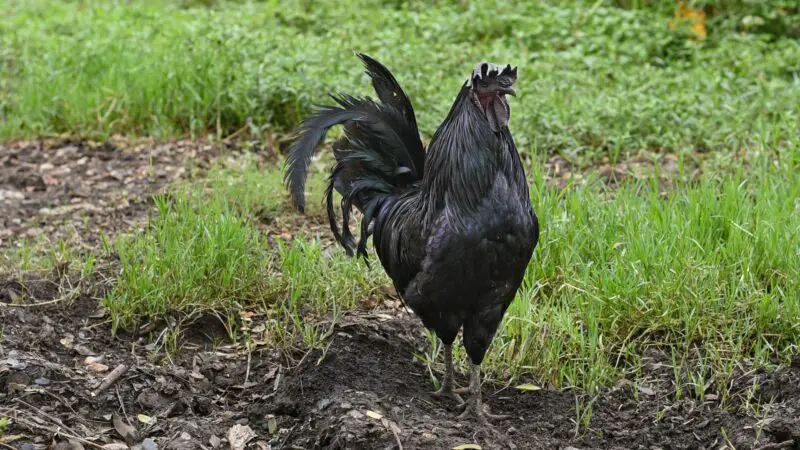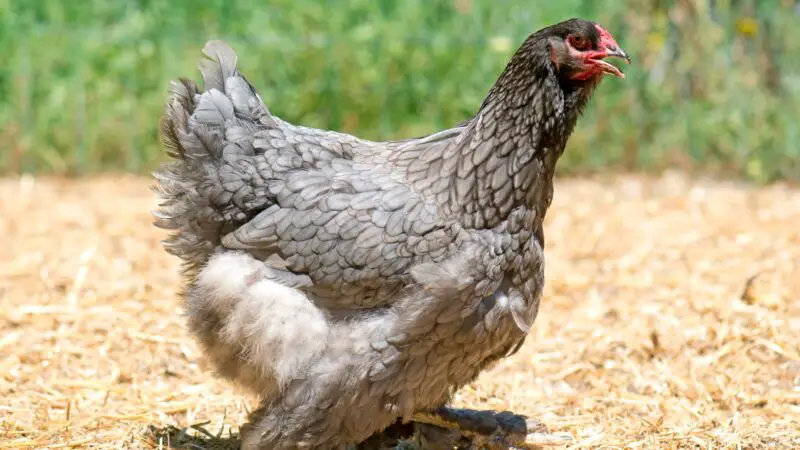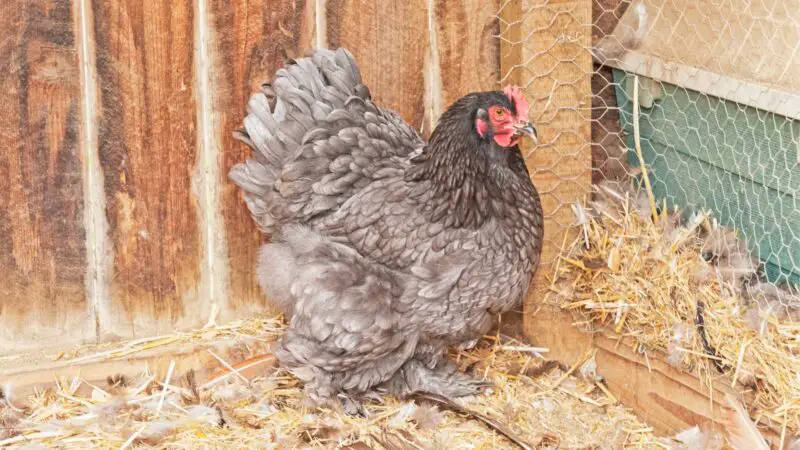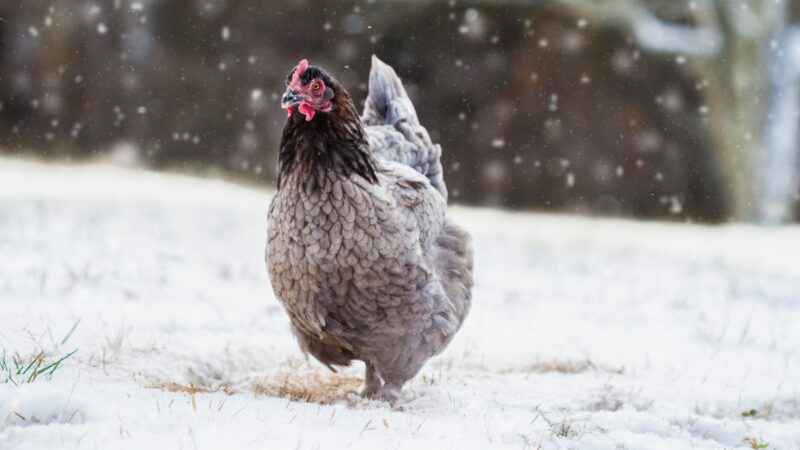If you are raising chickens and you prefer a unique and challenging breed, you should consider the Andalusian chicken. This very beautiful and elegant bird has distinctive characteristics that you seldom see in other chicken breeds. The Blue Andalusian chicken was admitted to the American Poultry Association (APA) Standard of Perfection in 1874.
The Andalusian chicken is a Mediterranean breed that is known for having blue plumage with black lacing. They are independent, active, and excellent layers.
Blue Andalusian chickens also have a hybrid characteristic, which means that not all of their chicks are automatically blue or have the same feather colors.
Raising Andalusian chickens can be tempting, especially for beginners. But before you get too excited, you should first understand their behavior, their major purpose, and how you can make the most of them.
This comprehensive guide will teach you everything about Andalusian chickens, including useful tips on how to take care of them properly.
Where Do Andalusian Chickens Originate?

The Andalusian chicken was named after Andalusia, a province in Spain. Its origin remains unknown, but this breed was believed to be a cross between Black Castilians and local breeds.
It is one of the oldest Mediterranean breeds, which Ancient Roman agricultural author Lucius Columella (4-70 AD) mentioned in his book, “De Re Rustica.”
Andalusian Chicken History
The first known Andalusian chickens came from Xeres de la Frontera (now Jerez de la Frontera), a city in Andalusia, Spain. They were imported to England by Leonard Barber from 1846 to 1847.
In the early 1850s, John Taylor of Shepherd’s Bush, London, and a certain Mr. Coles from Fareham, Hampshire also decided to import this chicken breed.
In some parts of England, Andalusian chickens were once called the Blue Minorca. This breed first went into an exhibit at the Baker Street Show, in London, in January 1853.
Andalusian chickens were imported to the United States sometime between 1850 and 1855. This chicken breed has bantam versions, which were created during the 1880s.
Are Andalusian Chickens Rare?
Andalusian chickens are rare. In fact, the Livestock Conservancy has listed this chicken breed as “Threatened.” This means that there are less than 5,000 Andalusian chickens globally, and less than 1,000 of them are in the US.
Andalusian chickens are also few in the UK. Hence, this breed is now under the care of the Rare Poultry Society.
Related: Are Sapphire Gem Chicken Rare | Unique and Friendly Birds
Andalusian Chicken Identification
What Do Andalusian Chickens Look Like?
Early Andalusian chickens had some physical similarities with pure Minora chickens. Ideally, their color is slate blue and paler than they have today.
This original blue variant has black lacing around the edges of its feathers, which makes them look black. The two other color variants are black and white, but both of them are not recognized.
Andalusian chickens have reddish-brown eyes, horn-colored beaks that are slightly curved downwards, white, oval earlobes, and black or slate-blue featherless legs. Each foot has four toes.
Their bodies are not so robust but are long and slender. The quality of their feather color and lacing mainly depends on the quality of their parents’ colors.
How Long Does an Andalusian Chicken Live?
Generally speaking, Andalusian chickens live between 5 and 8 years. They may also live up to 10 years if well taken care of. This is because this breed has no genetic problems or specific health issues.
But aside from giving them proper nutrition, the health condition of Andalusian chickens also depends on the climate where they live.
What Do Andalusian Chickens Eat?
Andalusian chickens eat fruits and vegetables, including apples, bananas, cabbage, carrots, corn, oats, and soybeans. This chicken breed can also be fed with commercial feed and food scraps.
But just like other chicken breeds, Andalusian chickens should not be given avocado skin, garlic, dried or raw beans, chocolate, and high-fat foods.
How Big Do Andalusian Chickens Grow?
Andalusian chickens are a large breed and have upright bodies. They are a bit bigger and taller than leghorns.
Roosters (adult males) can grow 22–26 inches (55-66 cm) tall, and hens (adult females) are about 20-25 inches (50–60cm) tall. Male bantams are 14 to 17 inches (35 to 45 cm) tall, while female bantams are 12 to 15 inches (31 to 38 cm) tall.
Are Andalusian Chickens a Heavy Breed?
Andalusian chickens are considered a heavy breed. Roosters weigh 3.2-3.6 kg (7.0–9.9 lbs), while hens are expectedly lighter at 2.25–2.70 kg (4.9–5.9 lb).
Male bantams weigh between 680 and 790 grams (1.5 and 1.7 lbs), and female bantams weigh between 570 and 680 grams (1.2 and 1.5 lbs). Pullets weigh about 2 kilos (4.7 lbs).
Andalusian Chicken Wingspan
Andalusian chickens have a wing length of 5.24 to 5.81 inches (13.3 to 14.7 cm), with an average wingspan of 18.5 inches (47 cm). They are very flighty birds and can fly over a fence at an average height.
How to Tell Male From Female Andalusian Chickens?
As mentioned earlier, male Andalusian chickens are bigger and heavier than females. Most roosters have larger combs as compared to hens.
They also have an erected comb, while females have combs that flop over. More importantly, roosters have darker feathers on top of their bodies, while hens have blue feathers all over their bodies.
What Is Andalusian Chicken Known For?
Andalusian chickens were originally bred for egg production and still are. Although a few breeders kept them for meat production, Andalusian chicken carcasses are considered less meaty than most meat breeds.
Nevertheless, their meat is quite tasty, with plenty of breast meat. But despite their beauty, Andalusian chickens are not ideal to have as pets.
What Are the Distinct Characteristics of an Andalusian Chicken?
The known distinct characteristic of Andalusian chickens is that their feather color shows a blending inheritance commonly called incomplete dominance. This means that neither trait of the parent is truly dominant over the other.
For this breed, its offspring may not always be blue. Below is the guide if you want to have blue Andalusian chickens:
- When two blue Andalusian chickens mate, 50% of the chicks will be blue, 25% will be black, and 25% will be “splash” (or mostly white with black markings).
- When two black Andalusian chickens mate, their chicks will be 100% black.
- When two “splash” Andalusian chickens mate, their chicks will be 100% “splash”.
- When blue Andalusian chicken mates with a “splash” variant, 50% of the chicks will be blue, and the other 50% will be “splash”.
- When blue Andalusian chicken mates with a black variant, 50% of the chicks will be blue, and the other 50% will be black.
- When black Andalusian chicken mates with a “splash” variant, its chicks will be 100% blue.
Are Andalusian Chickens Aggressive?

Blue Andalusian chickens are not necessarily aggressive but are neither docile. Hens are generally friendly to humans, but they don’t want to be touched or picked up.
On the other hand, roosters can be aggressive toward children. Therefore, this breed is not good to have in your yard if you have children who love touching chickens.
Are Andalusian Chickens Loud?
Andalusian chickens are loud and talkative, especially when confined. This noise factor should be considered if you are living near your neighbors, who may easily get annoyed. But despite being noisy chickens, they are quieter compared to other Mediterranean breeds.
Andalusian Chicken Temperament

Blue Andalusian chickens are very active and adventurous. They prefer foraging in wide spaces rather than in confinement.
Once confined in an enclosure, this chicken breed usually becomes nervous and starts to get noisy. If there are lots of them inside a small space, they may end up bullying and feather picking. In the worst cases, death can occur.
On the other hand, Andalusian chickens are quite friendly with other breeds. In fact, roosters are more aggressive toward humans and their hens compared to their treatment of smaller breeds.
This is why it is better to have them in a mixed flock rather than keeping them if you have small children or are living in an urbanized environment.
Are Andalusian Chickens Good Egg Layers?
Andalusian chickens are very good egg layers compared to most breeds. In fact, most hens continue laying eggs even during winter. No wonder this chicken breed is usually kept for egg production instead of meat production or as pets.
What Age Do Andalusians Start Laying?
Andalusian chickens are fast growers and reach maturity at an early age. Typically, pullets start to lay eggs once they are 5–6 months old. This means that pullets raised early in the year are expected to lay eggs in the same year.
How Often Do Andalusian Hens Lay Eggs?
Andalusian hens lay eggs all year round. Although they also lay eggs during winter, the frequency will be slightly lower. As expected, older hens will lay eggs not as often as the younger ones.
How Many Eggs Do Andalusian Chickens Lay?
During the 1890s, Andalusian chickens were known for laying 230 eggs a year, or 4-5 eggs a week. But as time passes by, their egg-laying capability has been reduced. Now they can only lay 150–65 a year or 2–3 eggs a week.
Note, however, that their lay rate will decline over the years. Typically, hens reduce about 20% of their lay rate per year.
What’s the Color of Andalusian Chicken Eggs?
Andalusian chicken eggs are white and medium to large. Each egg weighs about 70–80 grams (2.4–2.8 oz). Ideally, pullets lay small eggs at first. They will lay larger eggs the next time around until such time that their eggs will reach their standard sizes.
Are Andalusian Chickens Broody?

Andalusian chickens are not broody. This means that hens prefer laying eggs rather than sitting on them. Although they are not good mothers, this is a great advantage if you want many eggs.
But if you want more chicks, you will need broody hens from another breed or an incubator. Broody hens also tend to be aggressive once you get their eggs.
Breeding Andalusian Chickens
Breeding Andalusian chickens can be challenging if your space is small. Since they are very flighty birds, you also need higher fences so they cannot escape. Roosters also love to perch on tall trees.
Although they easily get along with other breeds, introducing new ones may lead to pecking order, which can be violent if not settled immediately.
Nonetheless, the most challenging part of breeding Andalusian chickens is if you only prefer the blue ones. You will need a lot of chicks to increase the chance of having the blue variety.
You should also have a huge space and be ready to give away those with different colors other than blue. If no one accepts them, your last resort is to cull them.
Andalusian Chickens Care Tips
Caring for Andalusian chickens can be a bit difficult if you live in cold climates. This is because their combs and wattles are huge, especially in males. Hence, they are prone to frostbite, which can be incredibly painful for them.
But because they are rugged, it makes them easy to take care of. Here are some caring tips for Andalusian chickens:
- During winter or colder months, coat their combs with Vaseline petroleum jelly to protect them from frostbites. Make sure their coop also has sufficient heat.
- Since Andalusian chickens are very active, check their feet frequently if there are signs of bumblefoot, which is a foot injury due to bacteria.
- Provide them with a very wide space with tall perches where they roam and roost freely.
- Aside from being free-range birds, they are also flighty. So, build a fence that is more than 6 feet high.
- To help them escape from predators, don’t clip their wings.
- Although they are heat tolerant, make sure their housing has proper shade if the weather is too hot.
- Treat them regularly to avoid having internal and external parasites.
- For maximum egg production, feed your hens with proper supplements.
Price of Andalusian Chicken?
The cost of Andalusian chicks depends on how many pieces you will buy. As of November 2022, the price range per male chick is from $3.89 to $4.54. Female chicks range from $5.68 to $6.62, while unsexed chicks cost between $4.63 and $5.40. The shipping fee depends on your location. Make sure you buy only from reputable hatcheries.
List of Sources
Chicken Breed Chart to Help Choose Your Chicken
Poultry Breeds – Andalusian Chickens
